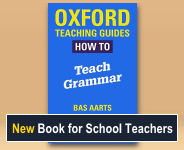Adverb identification
Applying the semantic and structural criteria for adverbs
In this activity, students work through the criteria for identifying adverbs.
Welcome back!

Englicious is totally free for everyone to use!
But you will have to log in to see our library of teaching resources.
If you don’t have an account, that’s perfectly OK. You can register (for free).
It only takes a minute or two.
»
- Printer-friendly version
- Log in to view or leave comments

